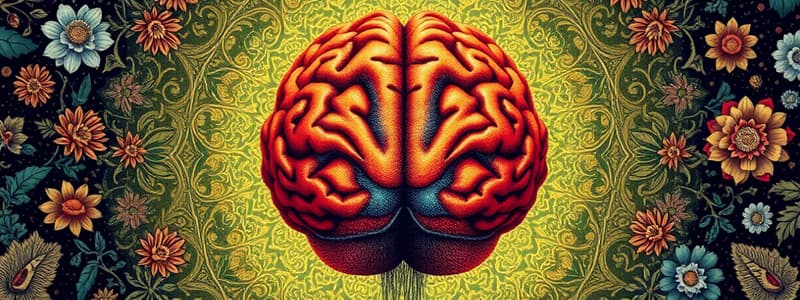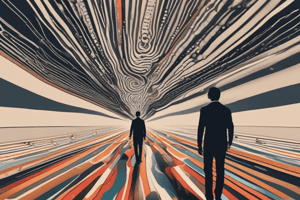Podcast
Questions and Answers
Which part of the brain is primarily responsible for conscious behaviors?
Which part of the brain is primarily responsible for conscious behaviors?
- Forebrain (correct)
- Neocortex
- Brainstem
- Cerebellum
What are the bumps on the surface of the brain called?
What are the bumps on the surface of the brain called?
- Fissures
- Gyri (correct)
- Spheroids
- Sulci
Which brain structure is central to controlling unconscious behaviors?
Which brain structure is central to controlling unconscious behaviors?
- Forebrain
- Brainstem (correct)
- Cerebellum
- Neocortex
The grooves on the surface of the brain are referred to as what?
The grooves on the surface of the brain are referred to as what?
What role does the neocortex serve in the brain?
What role does the neocortex serve in the brain?
How are neurons organized in the brain according to function?
How are neurons organized in the brain according to function?
What feature of the cerebrum allows for efficient connectivity of functional units?
What feature of the cerebrum allows for efficient connectivity of functional units?
What is indicated by the flow of information into and out of the brain?
What is indicated by the flow of information into and out of the brain?
What does the Principle of Proper Mass suggest about the relationship between brain size and behavior?
What does the Principle of Proper Mass suggest about the relationship between brain size and behavior?
How is the Encephalization Quotient (EQ) calculated?
How is the Encephalization Quotient (EQ) calculated?
What does the direct relationship between body size and brain size indicate?
What does the direct relationship between body size and brain size indicate?
Which of the following is a consequence of all animal species being related?
Which of the following is a consequence of all animal species being related?
What is the implication of stating that consciousness must be a product of the nervous system?
What is the implication of stating that consciousness must be a product of the nervous system?
What does a topographic map represent?
What does a topographic map represent?
Which of the following is part of the Peripheral Nervous System?
Which of the following is part of the Peripheral Nervous System?
Which lobe of the brain is primarily responsible for higher order hearing and language?
Which lobe of the brain is primarily responsible for higher order hearing and language?
What is the role of the autonomic nervous system?
What is the role of the autonomic nervous system?
What primarily connects the regions of the central nervous system?
What primarily connects the regions of the central nervous system?
Which division of the nervous system includes the brain and spinal cord?
Which division of the nervous system includes the brain and spinal cord?
What is mainly regulated by the parasympathetic nervous system?
What is mainly regulated by the parasympathetic nervous system?
Which of the following is NOT a type of system within the Peripheral Nervous System?
Which of the following is NOT a type of system within the Peripheral Nervous System?
What do optical illusions reveal about conscious experience?
What do optical illusions reveal about conscious experience?
How can illusions inform us about the brain?
How can illusions inform us about the brain?
Which statement best describes the concept of consciousness?
Which statement best describes the concept of consciousness?
What is the role of the brain in perception according to the illusions discussed?
What is the role of the brain in perception according to the illusions discussed?
What does the 'Dress' example illustrate about perceptual experience?
What does the 'Dress' example illustrate about perceptual experience?
Which approach to brain and behavior emphasizes the relationship between mind and body?
Which approach to brain and behavior emphasizes the relationship between mind and body?
Which method suggests that the brain prefers to expend minimal effort for visual processing?
Which method suggests that the brain prefers to expend minimal effort for visual processing?
How are auditory illusions indicated in the context of consciousness?
How are auditory illusions indicated in the context of consciousness?
What is the approximate number of neurons in a human brain?
What is the approximate number of neurons in a human brain?
Which factor is emphasized as important for brain function beyond just size?
Which factor is emphasized as important for brain function beyond just size?
How many neurons are approximately present in the cerebellum of a species with about 257 billion total neurons?
How many neurons are approximately present in the cerebellum of a species with about 257 billion total neurons?
What does EQ stand for in the context of brain function?
What does EQ stand for in the context of brain function?
What is the estimated number of neurons in a rat's brain?
What is the estimated number of neurons in a rat's brain?
Which brain region has approximately 68 billion neurons in a mammal with 86 billion total neurons?
Which brain region has approximately 68 billion neurons in a mammal with 86 billion total neurons?
In comparing neuron density, which species has a higher ratio based on provided figures?
In comparing neuron density, which species has a higher ratio based on provided figures?
What is the ratio of cerebrum neurons to total neurons in the human brain?
What is the ratio of cerebrum neurons to total neurons in the human brain?
Flashcards are hidden until you start studying
Study Notes
Mind and Conscious Experience
- Optical illusions challenge our understanding of conscious experience; perception is context-dependent.
- Individual experiences of consciousness vary; everyone perceives reality differently.
- Illusions provide insights into brain function, demonstrating how the brain completes and separates patterns.
- Neuroscience reveals that the brain is efficient; it attempts to minimize effort while processing visual information.
Types of Illusions
- Visual and auditory illusions, such as the "brain storm/brain needle," highlight different modes of perception.
- The "Dress" illusion exemplifies how individuals can interpret colors differently (white/gold vs. black/blue).
Historical Approaches to Brain and Behaviour
- Major perspectives include:
- Mentalism: Focuses on the mind as separate from the body.
- Dualism: Views the mind and body as distinct entities.
- Materialism: Asserts that mental processes are a product of physical brain activity.
Nervous System Divisions
- Central Nervous System (CNS): Comprises the brain and spinal cord, encased in bone.
- Peripheral Nervous System (PNS): Consists of all neuron cells outside the CNS, supporting bodily functions.
- Somatic nervous system: Controls voluntary movements via cranial and spinal nerves.
- Autonomic nervous system: Regulates internal organs and glands.
- Enteric nervous system: Manages gut functions autonomously.
Brain Structure
- The brain consists of:
- Forebrain: Involved in conscious behaviours; prominent in mammals and birds.
- Brainstem: Governs unconscious behaviours; acts as a central hub for information flow.
- Each hemisphere of the brain contributes to learning and movement coordination.
Neocortex and Brain Connectivity
- Neocortex, or cortex, is the brain's outer layer, characterized by gyri (bumps) and sulci (grooves).
- Local clusters of neurons perform similar functions, enhancing processing efficiency and connectivity.
Brain Size and Behaviour
- Encephalization Quotient (EQ) measures brain size relative to body size, indicating levels of complexity in behaviour.
- Larger brains tend to correlate with more complex behaviours, supporting Jerison's Principle of Proper Mass.
Key Statistics
- Average neuron count:
- Humans: Approximately 86 billion neurons.
- C. elegans: Approximately 302 neurons.
- Rats: Approximately 50-60 billion neurons.
- Larger species, like whales, possess significantly larger neuron populations, enhancing their cognitive capacities.
Evolutionary Implications
- All species are interrelated, suggesting a shared evolutionary trajectory in brain structure and behaviour.
- Consciousness and cognitive functions result from the development of the nervous system across species.
Studying That Suits You
Use AI to generate personalized quizzes and flashcards to suit your learning preferences.



